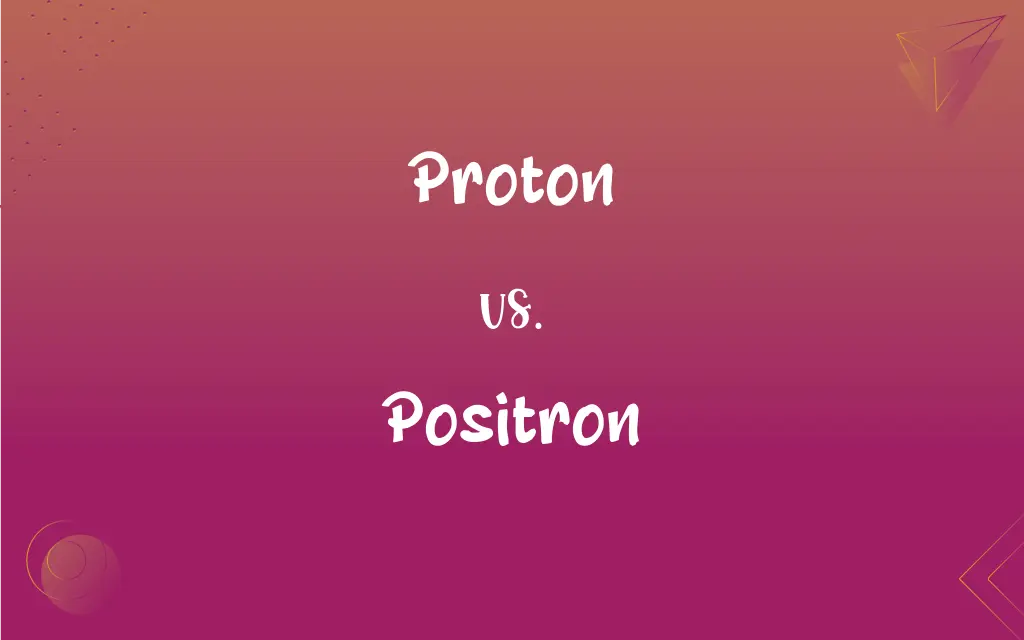Proton vs. Positron: What's the Difference?
Edited by Aimie Carlson || By Janet White || Published on December 12, 2023
A proton is a subatomic particle with a positive charge found in the nucleus of an atom, while a positron is the positively charged antimatter counterpart of the electron.

Key Differences
Protons and positrons are fundamental particles in physics, but they differ significantly in their properties and roles in the atomic structure. A proton is a subatomic particle found in the nucleus of an atom, carrying a positive electric charge. In contrast, a positron is the antiparticle of an electron, possessing the same mass as an electron but with a positive charge, opposite to the electron's negative charge. While protons contribute to the mass and define the element of an atom, positrons are rarely found in ordinary matter and are often produced in high-energy physics experiments or in certain types of radioactive decay.
The stability of protons and positrons is another key difference between these particles. Protons are stable particles and are one of the primary components of atomic nuclei, contributing to the identity and stability of elements. Positrons, however, are highly unstable in normal matter, as they annihilate upon encountering electrons, resulting in the production of gamma rays. This fundamental difference in stability means that protons are a constant presence in matter, while positrons exist only transiently under special conditions.
In the context of their discovery and theoretical significance, protons and positrons represent important milestones in particle physics. The proton was discovered in 1917 by Ernest Rutherford, and its discovery helped in understanding atomic structure and the strong nuclear force that binds protons in the nucleus. The positron was predicted by Paul Dirac in 1931 and discovered by Carl Anderson in 1932, providing the first evidence of antimatter and contributing significantly to quantum theory and the understanding of particle-antiparticle relationships.
The roles of protons and positrons in scientific applications are vastly different due to their distinct properties. Protons are used in various applications, including nuclear reactors and proton therapy for cancer treatment, exploiting their relatively large mass and charge. Positrons, on the other hand, find their use in Positron Emission Tomography (PET) scans in medical diagnostics, utilizing their property of annihilation with electrons to produce detectable gamma rays. These diverse applications highlight the unique roles that protons and positrons play in science and technology.
In terms of their presence in the universe, protons are far more abundant and play a critical role in the composition of matter. They are found in every atom and are a key component of stars, including our Sun. Positrons, in contrast, are not commonly found in the universe and are typically produced in high-energy astrophysical events, such as supernovae or the vicinity of black holes. This distinction underscores the fundamental differences in how protons and positrons are integrated into the fabric of the cosmos.
ADVERTISEMENT
Comparison Chart
Charge
Positive
Positive
Location in Atoms
Found in the nucleus
Not found in ordinary atoms
Role in Atomic Structure
Determines atomic number and element
Not involved in atomic structure
Stability
Stable in normal conditions
Annihilates with electrons, not stable
Usage in Science
Fundamental in chemistry and physics
Used in high-energy physics, medical imaging
ADVERTISEMENT
Proton and Positron Definitions
Proton
A proton is a positively charged particle in an atom's nucleus.
The number of protons in the nucleus determines the element's atomic number.
Positron
A positron is the antimatter counterpart of the electron, with a positive charge.
When a positron meets an electron, they annihilate each other.
Proton
A stable subatomic particle found in the center of an atom.
Hydrogen, the simplest element, has one proton in its nucleus.
Positron
Used in medical imaging, specifically in PET scans.
PET scans use positrons to create detailed images of the body.
Proton
One of the fundamental constituents of matter, along with neutrons and electrons.
In water molecules, each oxygen atom has eight protons.
Positron
Produced during particle interactions in accelerators.
Large particle accelerators can create positrons for experimental purposes.
Proton
A proton is essential in defining the chemical properties of elements.
The reactivity of an element is partly determined by its number of protons.
Positron
A subatomic particle with the same mass as an electron but positively charged.
Positrons are produced in certain radioactive decay processes.
Proton
A key particle in nuclear reactions and processes.
Nuclear fusion in the sun involves the merging of protons.
Positron
An unstable particle in antimatter physics.
In high-energy physics, positrons are studied for their antimatter properties.
Proton
The stable, positively charged nucleon, having a mass 1,836 times that of an electron and being a baryon composed of two up quarks and one down quark. The proton is a basic component of all atomic nuclei and the nucleus of the protium isotope of hydrogen.
Positron
An elementary particle having the same mass and magnitude of charge as an electron but exhibiting a positive charge; the antiparticle of the electron. Also called antielectron.
Proton
(particle) A positively charged subatomic particle forming part of the nucleus of an atom and determining the atomic number of an element, composed of two up quarks and a down quark.
Positron
(particle) The antimatter equivalent of an electron, having the same mass but a positive charge
The notion of a positron weapon remains the stuff of science fiction.
Proton
The atomic nucleus of protium hydrogen-1}}
Positron
An elementary particle with positive charge; interaction of a positron and an electron results in annihilation
Proton
Synonym of primordium
Proton
A stable particle with positive charge equal to the negative charge of an electron
FAQs
What is a proton?
A proton is a positively charged subatomic particle found in the nucleus of an atom.
How are protons important in chemistry?
Protons determine the atomic number and hence the chemical properties of an element.
Can protons change in number within an atom?
Changing the number of protons in an atom transforms it into a different element.
What is the role of positrons in medical imaging?
Positrons are used in PET scans to produce detailed images of internal body functions.
What happens when a positron meets an electron?
They annihilate each other, releasing energy in the form of photons.
Can protons be used in energy production?
Yes, in processes like nuclear fusion, protons play a key role in energy production.
Are protons stable?
Yes, protons are stable and do not decay under normal circumstances.
What is antimatter?
Antimatter consists of particles like positrons, which are mirror images of normal particles but with opposite charges.
How long do positrons last?
Positrons are short-lived in normal matter, as they quickly annihilate upon encountering electrons.
What is a positron?
A positron is a subatomic particle, identical to an electron but with a positive charge.
Where are positrons found?
Positrons are typically created in high-energy physics experiments and certain types of radioactive decay.
Do protons participate in chemical reactions?
Protons are involved in nuclear reactions, but electrons primarily drive chemical reactions.
Are positrons affected by magnetic fields?
Yes, like electrons, positrons are influenced by magnetic fields.
What is the charge of a proton?
A proton has a positive charge.
How are positrons created in particle accelerators?
Positrons are created in accelerators by colliding high-energy particles.
How many protons are in a hydrogen atom?
A hydrogen atom typically has one proton in its nucleus.
Do positrons occur naturally?
Positrons are naturally produced in certain types of radioactive decay.
What distinguishes a proton from a neutron?
A proton is positively charged, while a neutron is neutral and slightly heavier.
Is a proton bigger than an electron?
Yes, protons are much larger and heavier than electrons.
How are positrons used in science?
Positrons are used in research in high-energy physics and antimatter studies.
About Author
Written by
Janet WhiteJanet White has been an esteemed writer and blogger for Difference Wiki. Holding a Master's degree in Science and Medical Journalism from the prestigious Boston University, she has consistently demonstrated her expertise and passion for her field. When she's not immersed in her work, Janet relishes her time exercising, delving into a good book, and cherishing moments with friends and family.
Edited by
Aimie CarlsonAimie Carlson, holding a master's degree in English literature, is a fervent English language enthusiast. She lends her writing talents to Difference Wiki, a prominent website that specializes in comparisons, offering readers insightful analyses that both captivate and inform.






































































